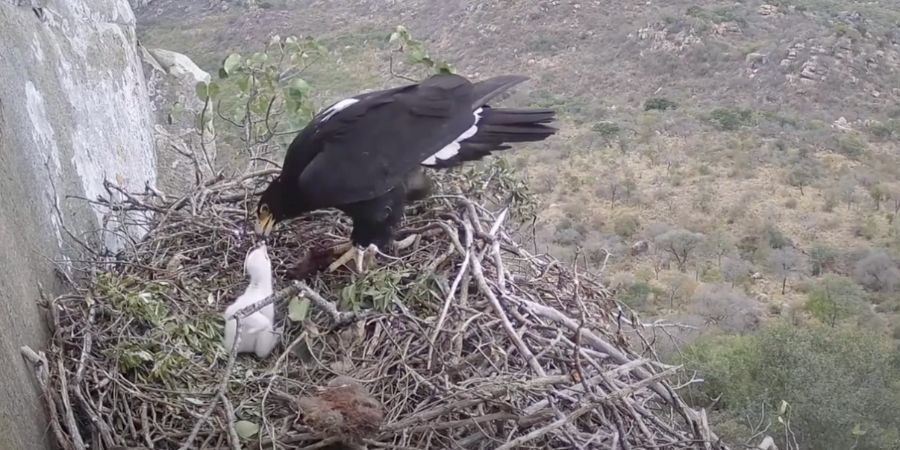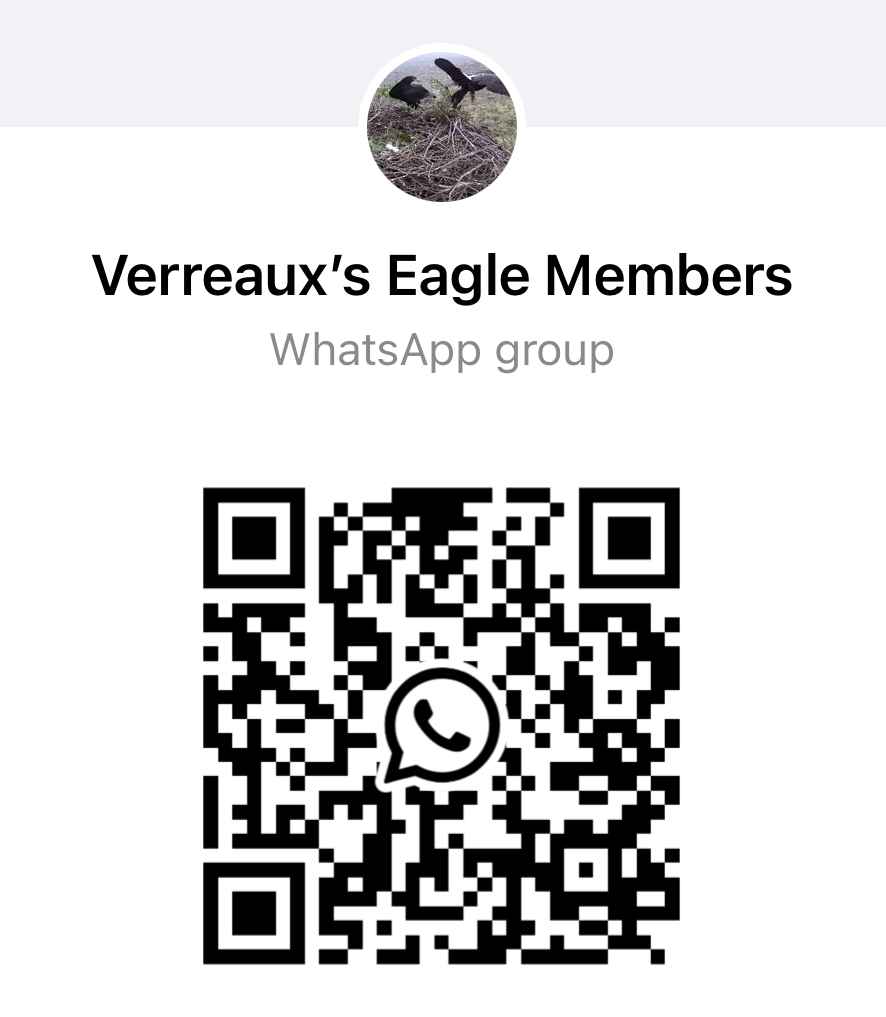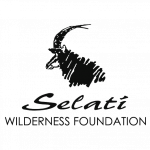

WELCOME TO SELATI'S VERREAUX'S EAGLE PROJECT
Welcome back to Selati’s Verreaux’s Eagle Project, now in its third year!
This unique conservation initiative not only employs cutting-edge live-streaming technology to provide unparalleled insights into the breeding behaviour of a pair of Verreaux’s Eagles within the Selati Game Reserve, but also plays a critical role in the conservation of these majestic raptors.
Last year, our live camera captured the full cycle of the eagles; nest building, egg laying, feeding of the remaining chick and eventually the successful fledging of the chick.
Verreaux’s Eagles typically breed once a year, raising one or occasionally two chicks. The breeding success of these eagles can vary, influenced by environmental factors and the challenges of chick-rearing. This year to deepen our understanding of these dynamics, we have installed a live-streaming infra-red camera system to hopefully further explore the behaviour at their nest during the night time hours. This setup documents their entire breeding cycle—from nest preparation to the fledgling’s first flight—while minimising disturbance to the birds.
Witnessing these magnificent eagles nurture new life is truly fascinating. We are excited to once again offer this exclusive window into the natural world to bird enthusiasts globally. Through our live camera feeds, viewers can observe the eagles and actively contribute to their conservation by joining the conversation. Viewers can also make donations to the Selati Wilderness Foundation.
Project Timeline: The project and live camera feeds will run through the end of the Verreaux’s Eagle breeding cycle, anticipated to conclude by the end of September when the fledgling leaves the nest.
For insights into our project’s inaugural year and the significant findings that have shaped our ongoing efforts, please visit https://selatiwf.org/verreauxs-eagles-selati/
📈 Eaglet Timeline
- Follow us here for updates
VIEW THE LIVE STREAM
We invite you to tune into our live stream below, offering a rare glimpse into the nest of the Verreaux’s Eagles, available daily.
If you have a burning question or an insightful observation about the Verreaux’s Eagles, we’re eager to hear from you. Whether you’re curious about their behaviour, habitat, our conservation efforts, or if you’ve made a fascinating observation while watching our live stream, feel free to share in the comments section of the YouTube livestream below. Your thoughts and insights greatly contribute to our community’s understanding and collective appreciation of these splendid birds.
We also invite you to consider making a donation to support the conservation of the Verreaux’s Eagles. More details about this can be found below on this page. Thank you for your generosity.
We appreciate your support!
Please note: Our live stream operates daily. In rare cases the stream may be temporarily unavailable due to technical reasons. If the stream is currently offline, we appreciate your patience and kindly ask you to check back soon while we restore the connection. Thank you for your understanding.
HIGHLIGHTS VIDEOS
Showcasing highlights from our Verreaux’s Eagle project, the videos below have been curated to offer an insider’s view of this exciting initiative. Dive in to understand the behind-the-scenes efforts that brought this project to life, as well as captivating moments from our Verreaux’s Eagle live stream.
HIGHLIGHTS PACKAGE 7 | WING FLAPPING
This highlight video consists of footage taken over a period of 2 weeks. It is exceptional to see how quickly this eaglet grows, as it learns to balance and stand. it is equally remarkable to see how the plumage of the chick develops at 2-4 day intervals between the clips.
The chick becomes more observant of its surroundings, taking in views from the height of the granite koppies – more often than not, keeping a watchful eye out for its parents and an incoming meal. The wing flapping exercises seen most prominently in the clips from 11, 15 and 18 August help the chick develop critical strength required for taking its first flight and becoming an independent eagle.
The video ends on 18 August where it’s clear that the chick has grown, taking on a lean looking body, comparative to its “fluff ball” state where the video begins on 3 August.
HIGHLIGHTS PACKAGE 6 | FEEDING
12 July
Remains of two Rock Hyrax on the nest and the female is feeding the young chick. She tears off a small piece and feeds it to the chick, which it easily swallows. The next bigger piece she keeps hold of allowing the chick to attempt at pulling pieces off by itself. She frequently retrieves the piece, either where it’s been dropped or from the chick’s beak as it struggles to swallow it, until the entire piece is consumed.
14 July
Remains of what looks like another Rock Hyrax on the nest. The female in the foreground, flies off and reveals the chick with a visibly distended crop. It has clearly just been well fed.
HIGHLIGHTS PACKAGE 5
The video opens at 06h31 the next morning and the chick has hatched. The female starts feeding the chick tiny pieces of red flesh she picks off the carcass of the Rock Hyrax (dassie) and delicately places it in the tiny beak of the chick. Ten minutes later the chick is replete and the female settles down to brood the chick. Observe how she keeps her talons out of harm’s way as she settles down onto the chick.
Newly hatched chicks have a tiny “horn” on the top of their beaks, referred to as the “egg tooth”. This drops off within a day and is used by the chick to break itself out of the egg. As demonstrated, it is a long and arduous job. We spotted the tiny hole, on the afternoon of the 28th June and the chick probably hatched late on the 29th June. Research has shown that this “struggle” is essential for the proper development of the chick.
HIGHLIGHTS PACKAGE 4
Video captured at x2 speed
The video opens at 07h13 on the 26th June, with an incubating eagle on the nest, which I assume is the female.
She, and possibly the male as well, are on and off the nest frequently and as the afternoon wears on, fresh green sprays are brought onto the nest to form a deeper nest cup. It is thought that eagles carefully choose greenery that has parasite repellent properties in order to sanitise the nest cup, a habit of raptors in general.
By the next morning, more greenery is ferried onto the nest and I have the opportunity to properly see the egg and it’s not cracked. Nest cup refurbishment is still underway into the late afternoon and because we are expecting the chick to hatch any day now, it’s obvious the adults are aware of this and preparing the nest for this event.
HIGHLIGHTS PACKAGE 3
This video opens at 6h29 on the 6th June and as expected an adult is sitting tight on the nest. When the adult stands up, only one egg is visible and it is clearly cracked, which is surprising because it’s not due to hatch until about 45 days after laying. About 90 minutes later the second egg appears on the screen and it’s difficult to understand why it wasn’t visible earlier. As the adult settles down again to resume incubation, she clearly appears to favour the cracked egg, because the 2nd egg, lies openly next to her. This is all very puzzling and also the last time we see two eggs on the nest. The adult frequently buries her head into the nest cup, below the egg. At 16h20 I can confirm it’s the cracked egg that she is still incubating. It’s very likely one of the eagles’ accidentally nicked the egg with its claw. This can easily happen when both adults are on the nest.
HIGHLIGHTS PACKAGE 2
15th May, an auspicious day because we can track exactly when the first egg was laid.
Most of the morning is spent constructing a deep nest cup, with both male and female ferrying a variety of green sprays onto the nest. One also notices how the nest rim facing away from the cliff is built up. This provides shelter for the small chick, as well as cover to remain out of sight from below.
The industrious pair are on and off the nest until midday, when there’s an hours break in activity, with no eagles on the nest.
Shortly after one o’ clock the female is back on the nest. More nest cup material is brought onto the nest. Light rain sets in and she hunkers down.
HIGHLIGHTS VIDEO 1 | CAMERA SETUP AT THE NEST
Welcome back to Selati’s Verreaux’s Eagle Project, now in its second year! Watch this video for a behind-the-scenes look at our Selati Research team as they return to the nest site to install a brand new infra-red camera and ensure all the equipment is in working order and ready for streaming. This year, to deepen our understanding of these majestic birds, we have installed a live-streaming infra-red camera system to explore their behaviour at the nest during night-time hours.
Thanks goes to Matt Niederer of the Selati Research Team for the drone & camera footage.
You can follow @TheMegaMatt & see more of his adventures as a Field Guide & Nature Enthusiast on his channel.
HIGHLIGHTS PACKAGE 1A
On 26 January 2023 the Selati Wilderness Foundation set off on a mission to install a non-invasive, live camera above the nest of a pair of Verreaux’s Eagles.
This required the skill of the Selati Research team who pulled together both a ground and air team to orchestrate the task.
JOIN OUR VERREAUX'S EAGLE WHATSAPP GROUP
Opt in and join our WhatsApp group for members. You will receive instant notifications from our research team on the ground so you’ll never miss an interesting moment at the nest site.
Scan the QR code via your mobile phone's QR scanner app >
Alternatively click on this link to join the group.
Don’t miss the chance to learn more about these fascinating birds, and help them survive and thrive in their natural habitat.

MAKE A DONATION
Please support us by making a donation below. Your contribution will play a vital role in supporting our conservation efforts.
The proceeds from contributions will go to the Selati Wilderness Foundation NPC and will be deployed to further the conservation objectives of the organisation. Your contribution will go a long way towards protecting Verreaux’s Eagles and other endangered species on the Selati Game Reserve.
SUPPORT THIS PROJECT
Disclaimer
While it is the intention to run this project for the duration of the Verreaux’s Eagle breeding cycle, the project is being conducted in the wild and there are a number of factors that could come into play that could result in early termination. These include inter alia damage to the equipment and/or nest due to weather or animals (elephant) or the birds abandoning the nest. We regret to advise that donations made will not be eligible for a refund in the event of an early termination.
THANK YOU FOR YOUR SUPPORT!



